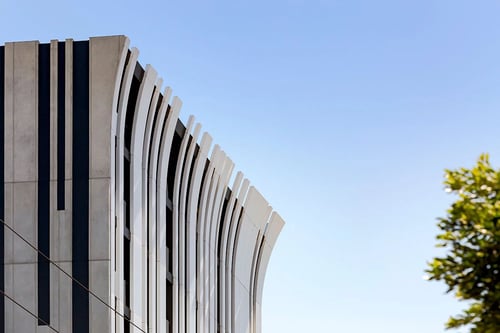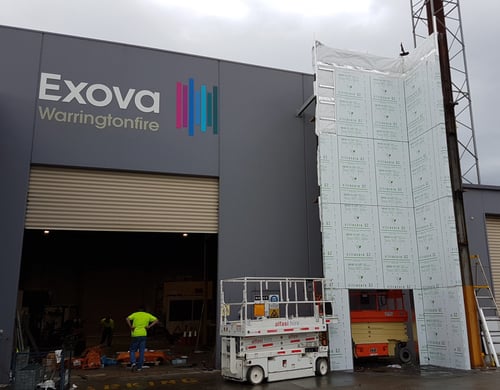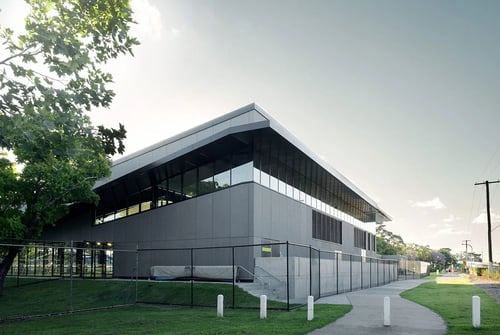Component testing
AS 1530.1 is a simple yet severe test method that has been used over decades. Simplified, if a sample in a small furnace flames for more than 5 seconds in a 30 minute period the sample is deemed combustible. The test is very severe and designed to allow a maximum of 0.5% combustible content. Many international building codes reference AS 1530.1 equivalents (such as ISO 1182, BS 476.4 or ASTM E136), but then provide for other avenues of compliance that are less onerous.
The Australian National Construction Code (NCC) requirement for non-combustibility of external walls to AS 1530.1 is based on the simple premise - a wall comprised of non-combustible components is extremely unlikely to spread fire. Engineers Australia have said “The building code is quite clear, you cannot have combustible external walls. It is looking at it from a fire engineering point of view; how each product impacts the building and the risk of it on an individual basis.” In other words, if the risk of each component is nil, then the overall wall risk is correspondingly low. There are many well documented external wall cladding failures in Australia and internationally. These are all products that do not or would not comply with AS 1530.1.
Large scale testing
Alternative evidence of compliance permitted under the building code is through large scale testing to AS 5113 (or similar under a Performance Solution). The NCC is quite deliberate in presenting large scale testing as an alternative, as limiting compliance to AS 5113 only would create some insurmountable issues for compliance. In particular, only one wall system is represented in each test. Given a single building features multiple wall designs this building would require multiple tests. Extend this to many buildings and the amount of tests are prohibitive.
For example, the UK had a significant façade fire at Garnock Court in 1999 which lead to the creation of their BS 8414 large scale test (which the AS 5113 is based on). Post the Grenfell tragedy, the UK government commissioned 7 large scale BS 8414 tests to understand how a variety of Aluminium Composite Panels perform in conjunction with a range of insulation products. This has resulted in 7 different tests with a range of unique wall and window opening constructions. These are very useful for assessing walls built in that exact method, but are unreliable for managing compliance or safety of the many differing designs.
Additionally BS 8414 large scale testing historically was designed for testing projects, not products. Product manufacturers may arrange testing (which if used needs to be reflected in the details onsite) but the reality is buildings are not built with a narrow range of unique wall details. This is demonstrated in the NCC verification method CV3 incorporating AS 5113. While CV3 has been in the market for over two years, and there are several manufacturers who have complete AS 5113 passes, no project I am aware of has yet used the CV3 route to compliance.
Another concept raised in favour of limiting compliance to large scale testing is waterproofing. Waterproofing relies on system performance - compliance is not to merely state the components are waterproof. However waterproofing and fire performance are two very different concepts and should not be compared.
Waterproofing is resisting water molecules driven by gravity or air. On the other hand, fire is a chemical reaction, which needs three components – fuel, heat and oxygen. Simply, fire performance by non-combustibility is removing the fuel, and therefore the fire.
However, I am not trying to make the point that AS 5113 is deficient. It is not that AS 5113 is inappropriate, but that large scale tested systems cannot be selected as the only route to compliance in lieu of all other methods. In reality, AS 1530.1 and AS 5113 are not better or worse than each other, but have different intentions and these need to be understood.
Allowances and Bonded Laminates
The extremely high requirements of AS 1530.1 do challenge the industry with complying with other requirements than fire, such as weather-tightness, condensation management, environmental sustainability, durability and finish aesthetics. To achieve these other purposes the ABCB has specifically selected certain exclusions to these requirements under C1.9d and C1.9e to improve overall wall performance.
These exclusions allow for the use of product with reduced or removed test requirements. For instance, the following products can be used without testing to AS 1530.1:
- Compressed Fibre Cement
- Plasterboard
- Sarking
- Sealant
- Painted sheet metal
The one provision that still maintains AS 1530.1 is the bonded laminates clause, which also requires additional testing to AS 1530.3. Allowing a small specific amount of adhesive between non-combustible layers, it is used for a range of external wall products including reflective insulation, insulated sandwich panels and lightweight cladding such as our Vitracore G2.
While the adhesive content is sometimes criticised, the NCC recognises these products are relatively low risk and unlikely to present a fire safety hazard. These products again demonstrate why the NCC relies on AS 1530.1 for compliance, preventing flame propagation. This theory has been demonstrated many times in both large-scale testing and real life fire scenarios.
The latest case involved an 8th floor unit in Melbourne's CBD. When a lit cigarette end started a fire amid books, papers and personal effects on a balcony with no external sprinklers, residents feared for the worst. But even at the fire locus, the Vitracore G2 cladding did not spread the blaze: The MFB report notes no signs of fire to external surfaces of the building, except to walls near the fire source. The exteriors were also clad in Vitracore G2, yet evidence shows zero facade ignition during the fire's 20+ minute duration.
Conclusion
Let us not criticise AS 1530.1, but use it sensibly – there is no evidence that Deemed-to-Satisfy products have significantly contributed to fire on a building. AS 1530.1 is not the cause of Australia’s cladding problems, nor is AS 5113 the saviour.
As stated by Bronwyn Weir: “Unfortunately, alleged non-compliant use of ACP is not just a storm in a tea cup, it's a symptom of significant problems in Australia's building and construction sector.” (https://www.linkedin.com/pulse/aluminium-composite-panels-attachments-bonded-laminated-weir/)




